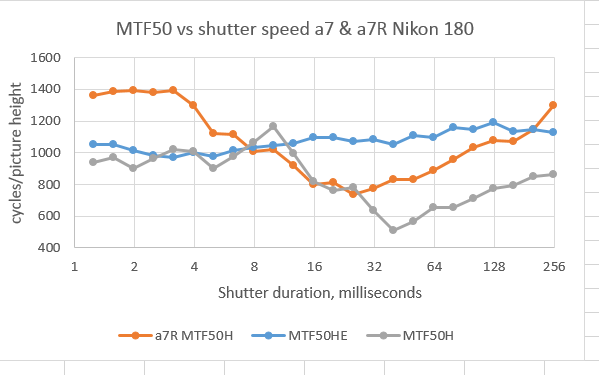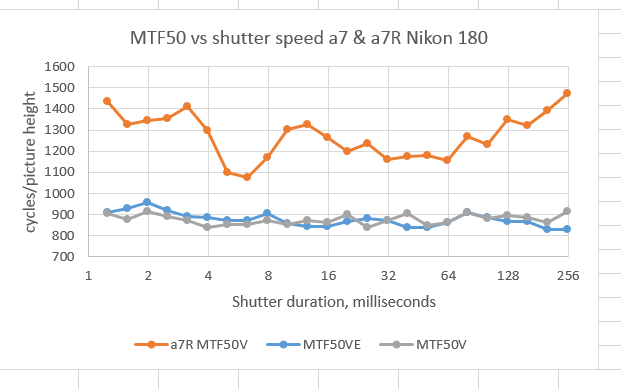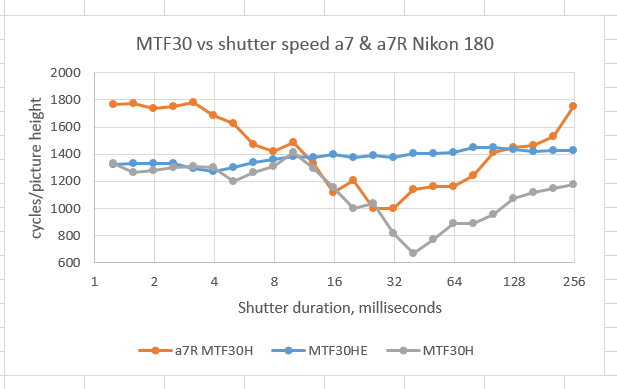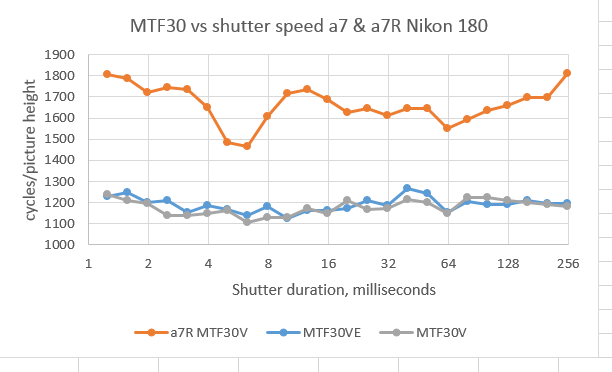When I presented this post to show how much the a7 suffers from shutter shock with and without the electronic first curtain shutter using the Zony 55, I wondered aloud why the a7’s mechanical first curtain shutter seemed to affect the sharpness less than the a7R’s mechanical FCS. In order to explore that issue in more detail, I used a Nikon AF Nikkor 180mm f2.8 ED instead of the Zony 55.
With both the a7 and the a7R, I mounted the lens to a Novaflex adapter, attached the Novoflex QR foot to the adapter in landscape orientation, added the camera, and attached the whole thing to an Arca Swiss C1 head which was attached to a set of RRS TVC-44 legs. Before you castigate me for using the a7R with an adapter collar, something that I and others have demonstrated is a bad idea, consider my motivations in this test. I’m not trying to find out the best way to mount the a7R when used with a smallish 180mm lens, I’m trying to find out if there’s something inherently different between the vibration of the a7 and a7R FCS, and this is a handy way to construct a fairly sensitive test setup. An adapter collar foot, while not a good way to mount a camera/lens assembly to the tripod with the a7R, works very well with the a7, as long as you use EFCS.
I mounted a Heliopan variable ND filter on the lens. I lit an Imatest SFRPlus target with a Fotodiox 5500K variable output LED source. I set the ISO to 400, focused wide open, and set the aperture to f/5.6. Using the ND filter and the light together to control the, and made a series of exposures of durations from 1/800 second through ¼ second at 1/3 stop intervals. With the light on full and shutter speed set to 1/800 at the start, I controlled the number of photons hitting the sensor with the ND filter until I got to 1/60 second, put the filter back to minimum absorption and set the light level with the Fotodiox control until I got to 1/50 second, then continued on attenuating the light with the ND filter.
I processed the images in Lightroom 5.3 with default settings except for cropping and white balance, then I processed them in Imatest, measuring the MTF30 and MTF50 for both vertical and horizontal edges. I converted the Imatest cycles/pixel data to cycles/picture height, and made plots.
Here’s the MTF50 for horizontal edges (the a7 curve with the EFCS on is indicated by the E suffix, and the a7R curve is identified in the prefix, the other two curves being for the a7):
The a7 and a7R are affected to about the same degree in this orientation, which has the shutter moving in the direction that blurs the (horizontal) lines the most. The a7R, having higher resolution to begin with, starts from a better position. The shutter speeds that are the most affected are somewhat different between the two cameras. These curves are slightly surprising to me; I would have expected the point of maximum blurring to occur at about the same resolution for both cameras.
For vertical edges, the main shutter vibrations are in the same direction as the edge, and thus the shutter’s effect is reduced:
This is a similar result to that obtained for horizontal lines with the Zony 55. The mechanical FCS of the a7 seems to have little effect, while the FCS on the a7R shows more variation with shutter speed. I believe that the reason is that the a7R is more sensitive to shutter vibration simply because of its higher resolution.
MTF30 for horizontal edges:
Except for the absolute values, and some minor variations, these are virtually the same as the MTF50 curves.
MTF30 for vertical edges:
Again, essentially the same information as in the MTF50 curves.
While the total magnitude of the two camera’s mechanical first curtain shutters vibration appears to be similar, the a7R appears to be of higher frequency, as it affects the faster shutter speeds relatively more. I’ve observed that the a7R shutter has an unusually large amount of high-frequency vibration before.




Good work Jim. That’s probably why Sony just came out with a firmware update that allows the use of the electronic shutter on the A7r as well. Here is some more reading on it
http://www.dpreview.com/forums/thread/3583280
and for a different take on the difference between horizontal and vertical readings:
http://www.dpreview.com/forums/thread/3606692
Jack, I’ve upgraded the firmware on my a7R, but I can’t find an electronic FCS setting like there is on the a7. Wouldn’t the a7R need a sensor change for this?
Jim
Apologies Jim, I got my wires crossed. The recent firmware update that introduces an electronic first shutter is for the Olympus E-M1, not the A7r – my mistake.